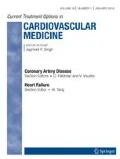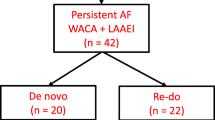Abstract
Interventional catheter ablation approaches to the rhythm control of atrial fibrillation (AF) have advanced significantly in the past decade. The foundation of the catheter ablation in AF is electrical isolation of the pulmonary veins (PVI). However, PVI only in more advanced stages of AF (persistent AF) has only modest to poor success rates prompting a search for alternative and adjunctive procedures to improve the outcomes of ablation in persistent AF. The left atrial appendage (LAA) is well understood to be a primary source of emboli in AF but less well known be a trigger or driver for AF. Therefore, LAA exclusion is an attractive target to potentially improve AF ablation outcomes in more advanced stages of AF and possibly as an alternative to chronic oral anticoagulation in the prevention of stroke and systemic embolism in AF. However, the precise role of LAA closure in the interventional approach to AF is still to be elucidated with ongoing clinical investigations.
Similar content being viewed by others
References and Recommended Reading
Papers of particular interest, published recently, have been highlighted as: • Of importance
Sherif HM. The developing pulmonary veins and left atrium: implications for ablation strategy for atrial fibrillation. Eur J Cardiothorac Surg. 2013;44(5):792–9. https://doi.org/10.1093/ejcts/ezt098.
Kanmanthareddy A, Reddy YM, Vallakati A, Earnest MB, Nath J, Ferrell R, et al. Embryology and anatomy of the left atrial appendage: why does thrombus form? Intervent Cardiology Clin. 2014;3(2):191–202. https://doi.org/10.1016/j.iccl.2013.11.002.
Di Biase L, Santangeli P, Anselmino M, et al. Does the left atrial appendage morphology correlate with the risk of stroke in patients with atrial fibrillation? Results from a multicenter study. J Am Coll Cardiol. 2012;60:531–8.
Romero J, Natale A, Di Biase LLAA. Morphology and physiology: “the missing piece in the puzzle”. J Cardiovasc Electrophysiol. 2015;26:928–33.
Kim DT, Lai AC, Hwang C, Fan LT, Karagueuzian HS, Chen PS, et al. The ligament of Marshall: a structural analysis in human hearts with implications for atrial arrhythmias. J Am Coll Cardiol. 2000;36(4):1324–7. https://doi.org/10.1016/S0735-1097(00)00819-6.
Di Biase L, Burkhardt JD, Mohanty P, Sanchez J, Mohanty S, Horton R, et al. Left atrial appendage: an under recognized trigger site of atrial fibrillation. Circulation. 2010;122(2):109–18. https://doi.org/10.1161/CIRCULATIONAHA.109.928903.
Yamada T, McElderry HT, Allison JS, Kay GN. Focal atrial tachycardia originating from the epicardial left atrial appendage. Heart Rhythm. 2008;5(5):766–7. https://doi.org/10.1016/j.hrthm.2007.12.025.
Krul SP, Berger WR, Smit NW, et al. Atrial fibrosis and conduction slowing in the left atrial appendage of patients undergoing thoracoscopic surgical pulmonary vein isolation for atrial fibrillation. Circ Arrhythm Electrophysiol. 2015;8(2):288–95. https://doi.org/10.1161/CIRCEP.114.001752.
Hocini M, Shah AJ, Nault I, Sanders P, Wright M, Narayan SM, et al. Localized reentry within the left atrial appendage: arrhythmogenic role in patients undergoing ablation of persistent atrial fibrillation. Heart Rhythm. 2011;8(12):1853–61. https://doi.org/10.1016/j.hrthm.2011.07.013.
• Di Biase L, Burkhardt JD, Mohanty P, et al. Left atrial appendage isolation in patients with longstanding persistent atrial fibrillation undergoing catheter ablation: BELIEF trial. J Am Coll Cardiol. 2016;68:1929–40. First randomized trial using LAAEI as the “adjunctive” addition to AF ablation demonstrating improved outcomes in LSPAF. This is reasonable evidence that the LAA or adjacent structures are an important AF trigger or driver.
Hwang C, Wu TJ, Doshi RN, Peter CT, Chen PS. Vein of Marshall cannulation for the analysis of electrical activity in patients with focal atrial fibrillation. Circulation. 2000;101(13):1503–5. https://doi.org/10.1161/01.CIR.101.13.1503.
Reddy VY, Holmes D, Doshi SK, et al. Safety of percutaneous left atrial appendage closure: results from the watchman left atrial appendage system for embolic protection in patients with AF (PROTECT-AF) clinical trial and the continued access registry. Circulation. 2011;123:417–24.
Holmes DR, Kar S, Price MJ, et al. Prospective randomized evaluation of the watchman left atrial appendage closure device in patients with atrial fibrillation versus long-term warfarin therapy: the PREVAIL trial. J Am Coll Cardiol. 2014;64:1–12.
Bartus K, Morelli RL, Szczepanski W, Kapelak B, Sadowski J, Lee RJ. Anatomic analysis of the left atrial appendage after closure with the LARIAT device. Circ Arrhythm Electrophysiol. 2014;7(4):764–7. https://doi.org/10.1161/CIRCEP.113.001084.
Han FT, Bartus K, Lakireddy D, et al. The effects of LAA ligation on LAA electrical activity. Heart Rhythm. 2014;11:864–70.
Badhwar N, Mittal S, Rasekh A, et al. Conversion of persistent atrial fibrillation to sinus rhythm after LAA ligation with the LARIAT device. Int J Cardiol. 2016;225:120–2.
Afzal MR, Kanmanthareddy A, Earnest M, et al. Impact of left atrial appendage exclusion using an epicardial ligation system (LARIAT) on atrial fibrillation burden in patients with cardiac implantable electronic devices. Heart Rhythm. 2015;12:52–9.
• Lakkireddy D, Mahankali A, Kanmanthareddy A, et al. Left atrial appendage ligation and ablation for persistent atrial fibrillation: the LAALA-AF Registry. J Am Coll Cardiol EP. 2015;1:153–60. First observational trial suggesting that suture-snare LAA exclusion may have an anti-arrhythmic effect similar to LAAEI by catheter ablation.
• Lakkireddy D, Afzal MR, Lee RJ, Nagaraj H, Tschopp D, Gidney B, et al. Acute and long-term outcomes of percutaneous left atrial appendage suture ligation: results from a United States multicenter evaluation. Heart Rhythm. 2016;13(5):1030–6. Largest multicenter registry of LARIAT suture-snare LAA exclusion success rates and complication rates. First published data on the improved safety of a microneedle approach to pericardial puncture. https://doi.org/10.1016/j.hrthm.2016.01.022.
Starck CT, Steffel J, Emmert MY, et al. Epicardial left atrial appendage clip occlusion also provides the electrical isolation of the left atrial appendage. Interact Cardiovasc Thorac Surg. 2012;15:416–8.
Romanov A, Pokushalov E, Elesin D, Bogachev-Prokophiev A, Ponomarev D, Losik D, et al. Effect of left atrial appendage excision on procedure outcome in patients with persistent atrial fibrillation undergoing surgical ablation. Heart Rhythm. 2016;13(9):1803–9. https://doi.org/10.1016/j.hrthm.2016.05.012.
Lee RJ, Lakkireddy D, Mittal S, et al. Percutaneous alternative to the Maze procedure for the treatment of persistent or long-standing persistent atrial fibrillation (aMAZE trial): rationale and design. Am Heart J. 2015;170:1184–94.
Verma A, Jiang CY, Betts TR, Chen J, Deisenhofer I, Mantovan R, et al. STAR AF II investigators. Approaches to catheter ablation for persistent atrial fibrillation. N Engl J Med. 2015;372(19):1812–22. https://doi.org/10.1056/NEJMoa1408288.
Author information
Authors and Affiliations
Corresponding author
Ethics declarations
Conflict of Interest
The authors declare that they have no conflicts of interest.
Human and Animal Rights and Informed Consent
This article does not contain any studies with human or animal subjects performed by any of the authors.
Additional information
This article is part of the Topical Collection on Arrhythmia
Rights and permissions
About this article
Cite this article
Lin, A.C., Knight, B.P. What Is the Role of Left Atrial Appendage Closure in the Rhythm Control of Atrial Fibrillation?. Curr Treat Options Cardio Med 20, 24 (2018). https://doi.org/10.1007/s11936-018-0620-4
Published:
DOI: https://doi.org/10.1007/s11936-018-0620-4




